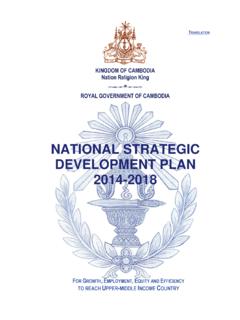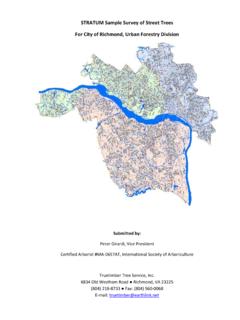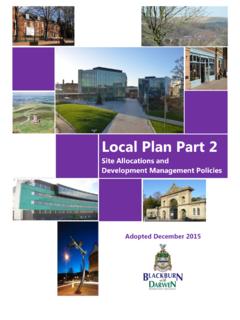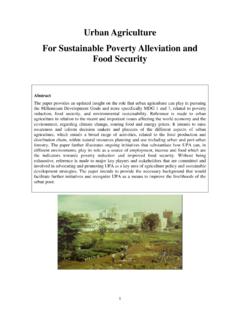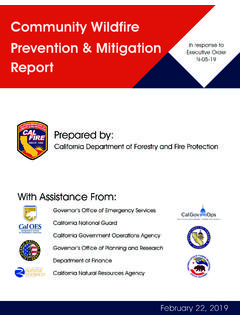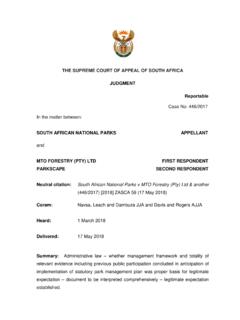Transcription of Urban Forestry Strategic Plan - City of Covington
1 City of Covington Urban Forestry Strategic plan For Publicly-Managed Trees April 2013. City of Covington Urban Forestry Vision Covington is dedicated to protect and manage the Urban forest in order to preserve and enhance its benefit to the environment and the livability of the community. The nation behaves well if it treats its natural resources as assets which it must turn over to the next generation increased, and not impaired, in value. - Theodore Roosevelt ACKNOWLEDGEMENTS. City Council Marlla Mhoon Mark Lanza Margaret Harto, Mayor David Lucavish Wayne L. Snoey Jim Scott Jeff Wagner Parks & Recreation Commission William Pand David Aldous Conni Elliott Steven Pand Elizabeth Fast Troy McIntyre Laura Morrissey Kollin Higgins (2012). Bryan Higgins (2012). Planning Commission Ed Holmes Sean Smith Sonia Foss Bill Judd Daniel Key Alex White Paul Max City Staff Glenn Akramoff, Public Works Director Bill Fealy, Maintenance Worker (Arborist).
2 Richard Hart, Community Development Director Salina Lyons, Principal Planner Derek Matheson, City Manager Nelson Ogren, Development Review Engineer Ben Parrish, Engineering Technician II. Scott Thomas, Parks and Recreation Director . Elizabeth Walker, Terra Firma Consulting Ian Hanou, plan -It Geo, LLC. Richard Thurau, plan -It Geo, LLC. Table of Contents Executive 1. Purpose .. 1. Introduction .. 1. Tree Canopy Cover .. 1. Vision Statement .. 2. Strategic plan .. 2. Summary Recommendations .. 2. 1. 4. 2. Covington 's Urban Forest Assessment & Analysis .. 5. A. Current City Policy and plan Review .. 5. B. Current Tree Cover i-Tree Assessment .. 6. C. Urban Forest Criteria and Indicators Matrix .. 7. 3. Public 8. 4. Proposed Objectives & Strategies .. 9. A. Criteria and Strategies .. 9. B. Key 10. Table - Covington 'S KEY Urban FOREST OBJECTIVES .. 11. 5. Recommendations.
3 14. Appendices A. Urban Tree Benefits B. City of Covington , Washington, i-Tree Canopy Land Cover Assessment C. Combined Survey Results on Criteria and Indicators Vegetative Resource Resource Management Community Framework Memo Summary of Survey Results Terra Firma D. Covington 's Desired Level of Service with Strategies for each Criterion Vegetative Resource Resource Management Community Framework E. Resources Executive Summary Purpose Covington is a rapidly growing new suburb and needs a logical direction for its Urban Forestry program. The city population has grown more than 40% during the 15 years since incorporation, and thousands of trees have been planted along new arterials, neighborhood streets and in parks. New trails and park facilities have been developed alongside existing trees. Conflicts with maturing trees and other maintenance issues require a reasonable and defensible Strategic plan for responsible stewardship and management.
4 Introduction Like other progressive municipalities, Covington has a goal to better manage its Urban forest, however, it's a small city with limited resources. Currently the city has thousands of trees that provide tremendous benefit and have high value, but no cohesive plan for managing these assets. With a grant from the Washington State Department of Natural Resources, in partnership with the USDA Forest Service, the City now has a clear direction for a more effective and cost- efficient management of public trees and Urban forest. Terra Firma Consulting was contracted to work with City staff to develop a Strategic plan that addresses how to manage and maintain public trees and lead the City to more specific action plans and budgets over time. The development of a Strategic plan was a collaborative process between the consultants and an assembly of City staff from the Planning, Parks and Public Works departments.
5 The group was known as the Tree Team throughout the project. The main outcomes of the process were 1) a general assessment of the city's tree canopy cover; 2) a vision statement for Urban Forestry ; and 3). key objectives and strategies for the Tree Team to build upon for a successful Urban Forestry program. The recommendations in this plan are provided to guide the community over the next five years regarding planning, management and maintenance of trees on publicly-managed properties (street rights-of-way, stormwater facilities, developed parks, and open space parks). The plan will also help promote a more unified effort to manage the entire Urban forest between the City and residents, business owners, utilities, and other tree stewards in the community. Tree Canopy Cover Before one can define strategies for managing a resource, it is critical to understand the existing condition and extent of the resource itself.
6 Terra Firma, in partnership with plan -it Geo, provided a snapshot of the amount of Urban tree cover in the city limits (private and public) as well as potential space for additional trees and other land cover, such as impervious surface. Using the i-Tree Canopy program, 600 random points were made throughout the city and designated as one of the three cover categories. Results utilizing 2012 high-resolution satellite imagery reveal that Covington 's overall Urban Tree Cover stands at approximately 37%. The nationally recommended goal for average cover is at least 40%. This general cover assessment is useful in setting goals to maintain a highly functioning Urban forest, especially during growth and development. The data City of Covington Urban Forestry Strategic plan April 2013 Page 1. and software can be used by City staff to further refine public tree cover analysis as well as gauge the change in tree cover levels over time.
7 Vision Statement The City has several established documents and plans that have guided its programs and policies. The two plans that resonate well with an Urban forest strategy are the Comprehensive plan and the Parks, Recreation and Open Space plan (2010). Upon review of the language in these plans around the environment and natural resources, the Tree Team proposes the Urban Forest Vision Statement as follows: Covington is dedicated to protect and manage the Urban forest in order to preserve and enhance its benefit to the environment and the livability of the community. Strategic plan Utilizing a model Urban forest sustainability matrix, the consultants developed a survey on key criteria and objectives for an Urban Forestry program. Each Tree Team member weighed in on both current and desired levels for each criterion, and collectively, the group proposes six major objectives for the City's Urban forest strategy: 1.
8 A comprehensive inventory of the tree resource to direct its management. 2. A detailed understanding of the condition and risk potential of all publicly-managed trees in order to be more responsive. 3. All publicly-owned, highly managed trees are maintained to maximize current and future benefits. 4. A detailed understanding of ecological structure and function of all publicly-owned natural areas to implement best management practices appropriately. 5. Ensure all city departments cooperate with common goals and objectives for Urban forest management. 6. The Urban forest is recognized by the public as vital to the community's environmental, social and economic well-being. Summary Recommendations The six key objectives identified by the Tree Team, and supported by the Parks & Recreation Commission and interested public, provide a solid basis for a reasonable and doable Strategic plan and annual work plans that are appropriate for the City.
9 Logically, the priority objective is to understand more about the public tree resource in order to better direct its management and maximize its benefits and function in the community. The recognition of good coordination with and within the City and other parties, including citizens and businesses, is also vital in achieving the Urban forest vision. City of Covington Urban Forestry Strategic plan April 2013 Page 2. The recommended Urban Forestry actions for the short-term are as follows: 1. Purchase a comprehensive tree inventory program and conduct an inventory of the public trees that includes condition and risk rating, where appropriate. 2. Generate a more accurate measurement of the public tree canopy cover by using the i-Tree software and initial database produced during this project. Establish a canopy goal for the City and commit to measure changes over time.
10 3. Develop an annual work plan for the maintenance of publicly-owned and managed trees based on the reports generated by the inventory program. 4. Recognize the interdepartmental Tree Team and enable them to develop work plans and budget requests, review policy, regulation and BMP's, and coordinate project-based Urban Forestry . 5. Strive to have more than one staff person (ideally one in each department Parks, Public Works, Planning) acquire arborist certification to provide interdepartmental support, and provide necessary training to ensure qualified staff for the management of the Urban forest. 6. Engage the community through neighborhood natural area planning (ex. Timberlane, Crofton Heights), annual work plan discussions, information on best management practices, and the general promotion of the benefits of the Urban forest. 7. Update and adopt the Community Forestry plan (2006) as the City's Best Management Practices for Urban Forestry .



